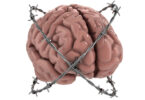Pseudobulbar syndrome is called a person who cries or laughs easily.
Pseudobulbar syndrome, also known as emotional incontinence or emotional lability for laughter or crying.
Thus, it is considered a disease in the neurological pathways that regulate feelings. In this condition we find a disproportion in the emotional expression of the patient, it is characterized by the presence of an exaggerated, inappropriate emotional expression in relation to the context of a situation that does not merit such behavior.
That is why it can be a symptom of disinhibition and emotional lability after acquired brain damage which is what produces pseudobulbar syndrome.
Generally, pseudobulbar syndrome occurs in people with certain diseases or neurological injuries that can affect the way in which the brain controls emotional expression.
The behavior of crying is a human and natural way of being able to vent, freeing stress and helping the person to get to assume situations that provide a lot of pain, as well as disappointments, failures, disappointments and disappointments.
Crying is an emotional reaction to a situation. The nature of that situation can come from different emotions: joy, sadness, anger, etc. Crying is the behavior in which crying is translated.
In the same way, crying is a universal reaction when we face a very intense loss or situation, a strictly human ability that has survived and sophisticated in the evolution of our species for some important reason. The degree of its anguish depends on the levels of development and previous experiences. We cry to communicate, balance our health and emotions and to keep our eyes healthy.
Tears release two essential substances that make people feel good: oxytocin and endorphins, also known as happiness hormones and decrease stress.
With crying, the respiratory rate increases to oxygenate the brain, which seeks to get tired. Physical pain or moral pain associated with active crying approximately 20 brain areas: cognitive, memory and learning, emotions and interpretation for the specific assessment of what makes us cry.
Crying is not bad, it is demonstrated that doing to some extent is good for health, because it is a self -defense mechanism that we have to vent when we are going through a certain moment.
When crying the eyes they swell because the vascular system of the eyelids is congested and the head hurts due to dehydration, it causes the body to lose water and bring these symptoms.
Causes:
These causes are suffered by people believed have neurological lesions, such as: stroke
Amyotrophic lateral sclerosis, multiple sclerosis, traumatic brain injury, Parkinson’s disease and Alzheimer’s disease.
Diagnosis:
The diagnosis of this condition, the doctor will evaluate according to symptoms and behavior, along with an examination of their medical background.
Treatment:
On the other hand, the treatment is with the indication of specific medication for the pseudobulbar and antidepressant condition. The dose is established by the doctor.
Therefore, we can affirm that crying or laughing when it is not the time can be a consequence of the pseudobulbar syndrome. When a person cannot cry is called Anhedonia and often happens as a symptom of depression. And laughter is also considered laughter for no reason.
FONT
https://www.cigna.com/es-us/knowledge-center/hw/temas-de-salud/afectacin-pseudobulbar-abr9139
https://centromedicoabc.com/padecimientos/afeccion-pseudobulbar/
https://www.tmcaz.com/health-library/conditions/es/con-20192124







